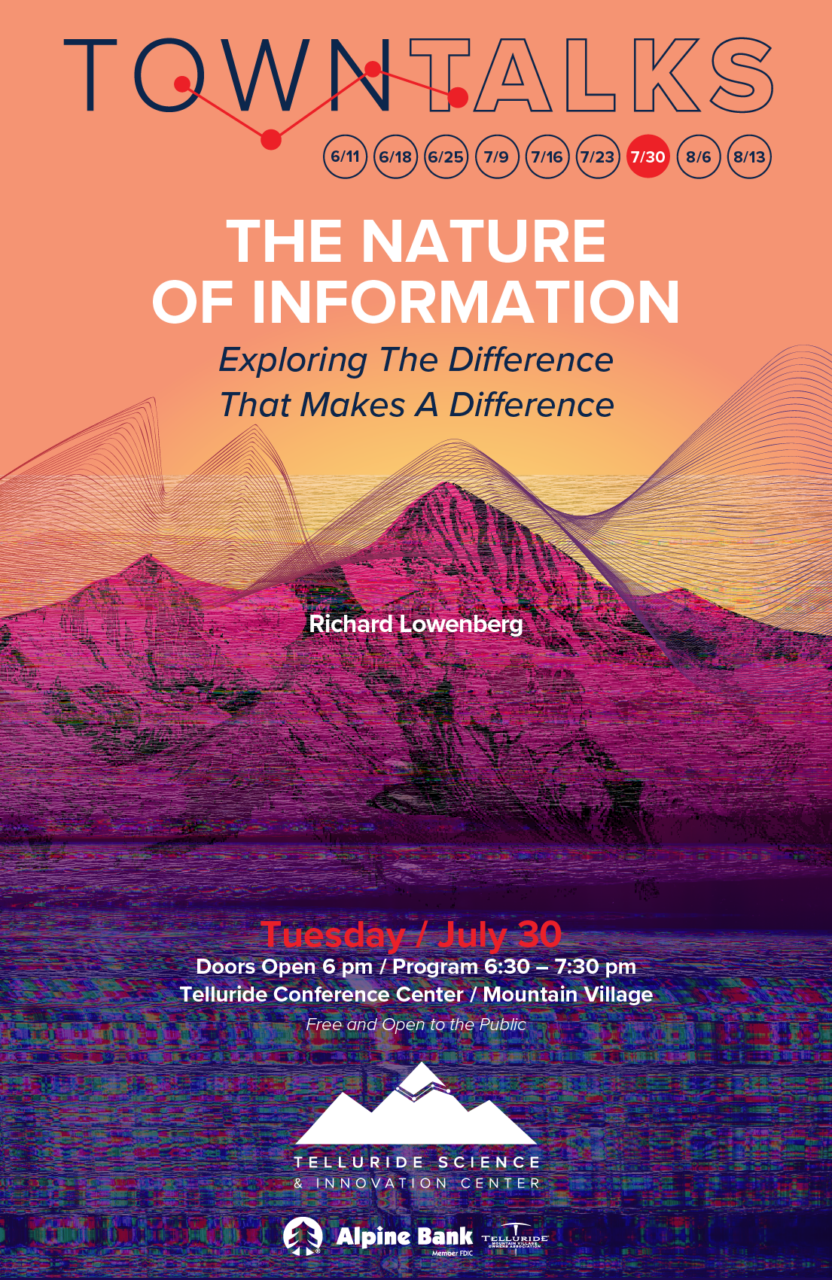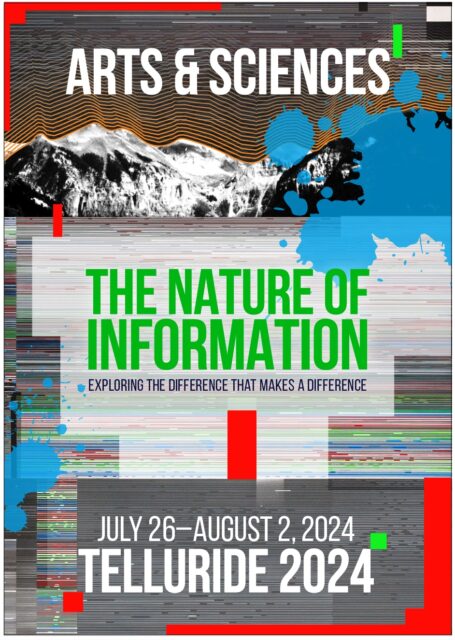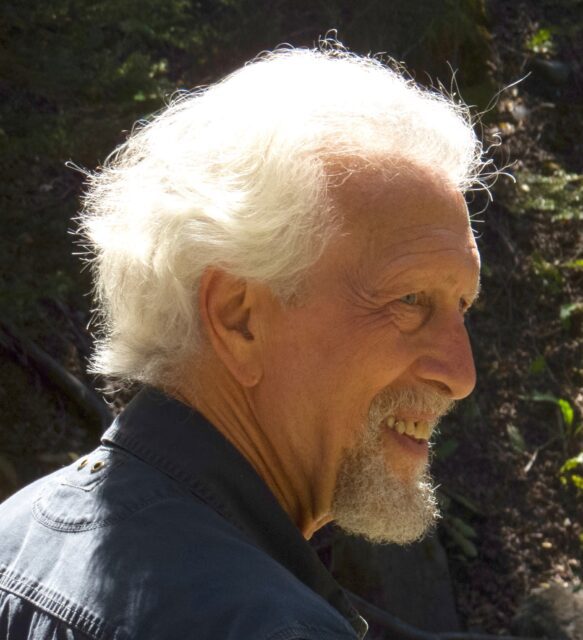
23 Jul Telluride Science Town Talk: “The Nature of Information,” 7/30 + Arts & Sciences Festival Information!
This coming week the 2024 Telluride Science Town Talks series continues with Richard Lowenberg. His subject is titled “Arts & Sciences: The Nature of Information.” The event takes place Tuesday, July 30, 6:30 pm; doors, 6 p.m., at the Telluride Conference Center in Mountain Village.
Town Talks are FREE and open to the public.
The 2024 Telluride Science Town Talks series is being presented by Alpine Bank with additional support from the Telluride Mountain Village Owner’s Association.
Visit telluridescience.org to learn more about Telluride Science and the capital campaign to transform the historic Telluride Depot into the Telluride Science & Innovation Center. The venue is soon to be a permanent home for Telluride Science and a global hub of inspired knowledge exchange and development where great minds get to solve great challenges.
The 2024 Telluride Science Town Talks series is being presented by Alpine Bank with additional support from the Telluride Mountain Village Owner’s Association.
Go here for more about Telluride Science. (back to 2009).
Go here for more on Town Talks.
Go here for the full schedule of “Telluride Arts & Sciences 2024,” including presenters and participants.


Fact: Our small town, renowned internationally as a ski resort and cultural center, has also been the birthplace of Big Ideas in science and technology.
Telluride turned into a science experiment in 1891 when LL Nunn and Westinghouse used Nikola Tesla’s electrical current discovery to send about 2.5 miles of power line from a hydroelectric plant located in Ames to the Gold King Mine.
(Go deeper into that story here. https://tellurideskiresort.com/a-tale-of-two-teslas/)
In 1984, Stephen Berry, University of Chicago chemistry professor, and Peter Salamon, San Diego State University mathematics professor, brought 18 scientists to Telluride for a workshop because they found the remote San Juan Mountains inspirational. The gathering launched the Telluride Science Research Center, now Telluride Science, a nonprofit dedicated to bringing together international scientists to debate, discuss, and discover new directions for scientific research. Early workshops focused on thermodynamics, chaos theory, clusters, spectroscopy, and intermolecular dynamics. This July, Telluride Science celebrates its 40th anniversary.
In addition, as Director of the Telluride InfoZone, the work of long-time, former local Richard Lowenberg ensured that Telluride became the world’s very first rural Internet PoP (Place of Presence,) and first wireless community network (1990-1996). In other words, Telluride had access via a local telephone line to the Internet. (Lowenberg’s InfoZone also ensured Telluride Science got connected.)
In truth, Richard Lowenberg, an artist, planner/designer and eco-cultural activist, – a unicorn – has dedicated over 50 years of his uniquely creative life to realization of works exploring and setting examples for an “ecology of the information environment,” resulting in numerous opportunities for growing a vibrant cultural economy,
Case in point, when he first landed in our box canyon in 1979, Lowenberg hosted a 10-day, National Endowment for the Arts-funded, invitational workshop dubbed “Arts & Sciences -Telluride,” featuring 20 invited participants.
His upcoming festival-like event in town is titled “Art & Sciences: Telluride 2024, The Nature of Information” is the encore for that event.
The happening, which principally takes place online, is scheduled for Friday, July 26, through Friday, August 2. Topics include “Physics, Information and the Origin of Life”, “Ecological Economics of Information,” “Space, Signs and Signals,” “Photonic Futures,” and “Artful Intelligence.”
For more, check out Telluride Inside…and Out’s email interview with Richard Lowenberg.

Richard Lowenberg, courtesy the presenter.
TIO: Let’s begin by parsing the title of your talk “The Nature of Information: Towards an Ecological Understanding of the Information Environment.” How do you define “information”? How do you define “ecology”?
RL: Most of us use the word ‘’information’ to refer to our verbal, visual or other sensory stimuli, or to books, film and other media, increasingly to data and internet exchanged communications, while now adding AI to the mix. That is the emergent evolution of the so-called Information Revolution.
But information is much more. Physics now indicates that at a macro scale, information, energy and matter are fundamental to the formation and evolution of the Universe. And, at the micro scale, information and communication are determining factors in the bio-chemical origin of life, amid development and reproduction of lipids, proteins, RNA and DNA.
At the scale of our Earth, all living things, from cells, to plants, to butterflies, to fish, to us, are variously metabolically in tune with electromagnetic energies, sensing, communicating, creating, reproducing, responding, storing and recalling information, as it intangibly and invisibly permeates the Biosphere. That planetary information environment or ecosystem is sometimes referred to as the Noosphere. Information exchange is a key inter-relational part of all of Nature.
Ecology, is largely misunderstood by experts and most of us, as a subset of Biology, referring to the complex relationships within studied “natural” ecosystems. However, Ecology is better considered as a co-evolutionary, whole systems study and understanding, complexly inclusive of inter-dynamic material, energy and information processes.
TIO: What is the “information environment” and its relationship to ecology?
RL: Information is everywhere and in everything. A better ecological understanding of the information environment is a needed, but dauntingly complex undertaking, which requires open minded, life-long learning and caring. It is about time. Our best intended actions to address and mitigate our impacts on climate change, limited natural resources over-consumption, needed economic and political changes, paths to greater social equity and the many other so-called “Grand Challenges” cannot be effectively realized without greater inclusive understanding of “The Nature of Information.”
TIO: Based on those definitions, in what significant ways does the nature of information impact our everyday lives with regard to economics, to energy, to politics, to the arts? Please be specific and as plainspoken as possible and give a few examples.
RL: Though information seems invisible, much like the environmental impacts of industrialism, extraction and manufacturing, we live amid ever increasingly greater noise-to-signal ratio, and in poorly understood ways, are greatly polluting the information environment. While material ecology attempts to understand the delicate balancing act between valued resources on one side of the scale, and waste on the other side, we are ideally moving to implement recycling and circular eco-processes.
The ecological economic balancing of information, however, is qualitative rather than quantitative. Valued information is understood as knowledge, wisdom, creativity and inspiration, while waste is characterized as ignorance, deception, confusion and overload. Eco-socially, the latter represent impacts on our overall cognitive health and sustainability.
In the early 1990s, at a meeting I attended, convened by the Department of Commerce in DC, the topic was “What is the New Digital Economy?” After two full days the agreed consensus of invited government leaders, corporate executives and academic experts was that “information is property,” to be regulated by government, developed, owned and managed by corporations, and rented on a monthly subscription basis to consumers. Though simplistic, that is one indicator.
Others have since and are now conceiving of an Information Commons, much like Eleanor Ostrom’s Nobel Prize-awarded work on understandings and application of the commons to wetlands, forests, the air we breathe, and the core of some communities, where all share in the stewardship and in the benefits. The InfoZone was one such an attempt. KOTO and community radio are fragile, but thriving examples.
TIO: Now let’s drill down to home base. Might the arts and science, which you say are converging at a rapid pace, and attempts to understand the information environment, be applied to the future of the Telluride region? Assuming yes, in what ways? Just a few examples of what might be possible.
RL: With all its problems, mistakes, beauty and realities, Telluride has achieved many notable successes, led by and participated in by many of the caring and capable residents of the regional community. Having a strong sense of community, of learning and doing and celebrating, are a foundation for all acts of “right livelihood.” How we apply our informed actions with “common sense,” can continue by example, to be the basis for a sound and adaptable environment, economy and home.
TIO: Richard. You were born in Haifa, but then lived in New York, the Bay Area and Santa Fe before landing in Telluride and starting the first iteration of “Arts & Sciences” in September 1979. What about our box canyon appealed? And please talk briefly about some of your most significant Telluride regional community planning and design projects. We are particularly interested in the InfoZone and its echoing ramifications.
RL: I was born in British Mandate Palestine to German Jewish Holocaust survivors who were not Zionists. We therefore emigrated to The US when I was five. For our first six years we lived and worked on five different New Jersey farms. I enjoyed rural life, but dreamed of the Rocky Mountains I saw on calendars. I was a creative kid, fascinated by art, Zen and Leonardo’s notebooks, eventually having a good architecture, design and filmmaking education at Pratt Institute in New York.
By 1970, I was becoming involved with experimental theater, video art, electronic music and the new Information Revolution, while also learning about Cybernetics, Information Theory and the emerging environment and ecology movements, attending the first Earth Day. Moving to the Bay Area, supporting myself with architecture and design projects, I approached NASA Ames Research Center, in the early days of Silicon Valley, with a proposed arts and sciences collaboration. Realized in small steps, that nearly 10 year series of projects, included use of the ARPAnet, first artists’ use of satellite tele-communications, and choreographing and filming dancers and gymnasts in various gravitational simulation trainings, eventually involved NASA Headquarters and other NASA facilities around the country.
On a trip to London in 1975, I met John Lifton. In 1976, we collaborated on creation of “plant sensing music” sequences for the feature film, “The Secret Life of Plants.” After John, Pamela and kids had moved to Telluride, I visited them in Spring of 1979. I had just received a National Endowment for the Arts grant to organize and host a 10-day Arts & Sciences working meeting with 20 invitees, to be held at the Exploratorium in San Francisco. Upon visiting Telluride, the location was changed, for a wonderfully inspiring program.
I relocated as well, and from Fall 1979 through Fall 1996, I was involved with Mountain Village design and planning, other regional design and planning projects, and was a part of the founding team of the Telluride Institute from 1984 through 1996, co-stewarding annual Ideas Festivals, Composer to Composer programs and leading the InfoZone, which made Telluride, inspired by Telluride’s AC power history 100 years earlier, the first rural community connected with the Internet by 1992.
That happening involved me in other rural community Internet projects around the world for many years. Towards the end of 1996, I moved back to California to care for elderly parents. Locating in Davis, I became director of Davis Community Network and taught Techno-culture Studies at the University. During my years in and after Telluride, I continued to work on a series of personal collaborative arts/sciences/society projects, with shows at the San Francisco Museum of Modern Art, Whitney Museum, MIT List Center, NTT Japan and the 1986 Venice Biennale.
In 2006 I again returned to the Four Corners region, settling in Santa Fe. From 1998 through 2013, I was contracted by the then Governor Richardson, to lead my proposed “New Mexico Broadband for All” plan, bringing to statewide ISPs, communities and tribal recipients just under $380 million in Obama-stimulus funding for improved broadband networking.
In 2012, I organized an Arts/Sciences program with Los Alamos and Sandia National Labs, Santa Fe Institute and UNM, and with the Internet Society, I organized the first Indigenous Connectivity Summit, held in Santa Fe in 2017.
Since then my creative efforts have been focused on workshops, exhibitions and a book project titled “Info/Eco.”
TIO: Why resurrect Telluride Arts & Sciences now? And what impact do you hope your upcoming event will have on the greater Telluride community and beyond, globally.
RL: The arts and the sciences are information. Arts & Sciences 2024, like the program in 1979, is simply a milestone along a personal path, as noted previously. It is in part a means for personal creative expression, as well as for collaborative innovation, much like good theater.
From the beginning, Arts & Sciences was intended to be a cultural, community-building gift to Telluride.
Right now I’ am not thinking much about post-effects of the event. However, I hope and look forward to community interest and participation, with comments, ideas and questions that should naturally lead to possible next steps.
Why? Because like the flow of water irrigating our fields, the flow of information has nurtured the evolution of all life on this planet, and shaped the course of our human history.


Sorry, the comment form is closed at this time.